change wheel Alfa Romeo 156 2004 Owner handbook (in English)
[x] Cancel search | Manufacturer: ALFA ROMEO, Model Year: 2004, Model line: 156, Model: Alfa Romeo 156 2004Pages: 357, PDF Size: 5.04 MB
Page 48 of 357
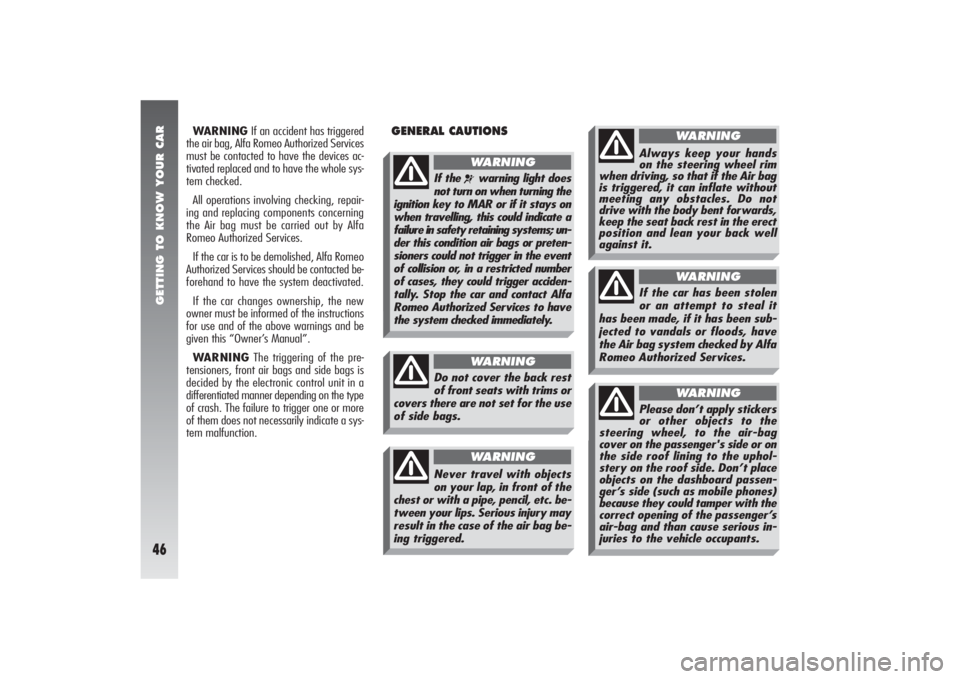
GETTING TO KNOW YOUR CAR46
WARNINGIf an accident has triggered
the air bag, Alfa Romeo Authorized Services
must be contacted to have the devices ac-
tivated replaced and to have the whole sys-
tem checked.
All operations involving checking, repair-
ing and replacing components concerning
the Air bag must be carried out by Alfa
Romeo Authorized Services.
If the car is to be demolished, Alfa Romeo
Authorized Services should be contacted be-
forehand to have the system deactivated.
If the car changes ownership, the new
owner must be informed of the instructions
for use and of the above warnings and be
given this “Owner’s Manual”.
WARNINGThe triggering of the pre-
tensioners, front air bags and side bags is
decided by the electronic control unit in a
differentiated manner depending on the type
of crash. The failure to trigger one or more
of them does not necessarily indicate a sys-
tem malfunction.
GENERAL CAUTIONS
If the
¬
warning light does
not turn on when turning the
ignition key to MAR or if it stays on
when travelling, this could indicate a
failure in safety retaining systems; un-
der this condition air bags or preten-
sioners could not trigger in the event
of collision or, in a restricted number
of cases, they could trigger acciden-
tally. Stop the car and contact Alfa
Romeo Authorized Services to have
the system checked immediately.WARNING
Do not cover the back rest
of front seats with trims or
covers there are not set for the use
of side bags.
WARNING
Never travel with objects
on your lap, in front of the
chest or with a pipe, pencil, etc. be-
tween your lips. Serious injury may
result in the case of the air bag be-
ing triggered.
WARNING
Always keep your hands
on the steering wheel rim
when driving, so that if the Air bag
is triggered, it can inflate without
meeting any obstacles. Do not
drive with the body bent forwards,
keep the seat back rest in the erect
position and lean your back well
against it.
WARNING
If the car has been stolen
or an attempt to steal it
has been made, if it has been sub-
jected to vandals or floods, have
the Air bag system checked by Alfa
Romeo Authorized Services.
WARNING
Please don’t apply stickers
or other objects to the
steering wheel, to the air-bag
cover on the passenger's side or on
the side roof lining to the uphol-
stery on the roof side. Don’t place
objects on the dashboard passen-
ger’s side (such as mobile phones)
because they could tamper with the
correct opening of the passenger’s
air-bag and than cause serious in-
juries to the vehicle occupants.
WARNING
Page 50 of 357
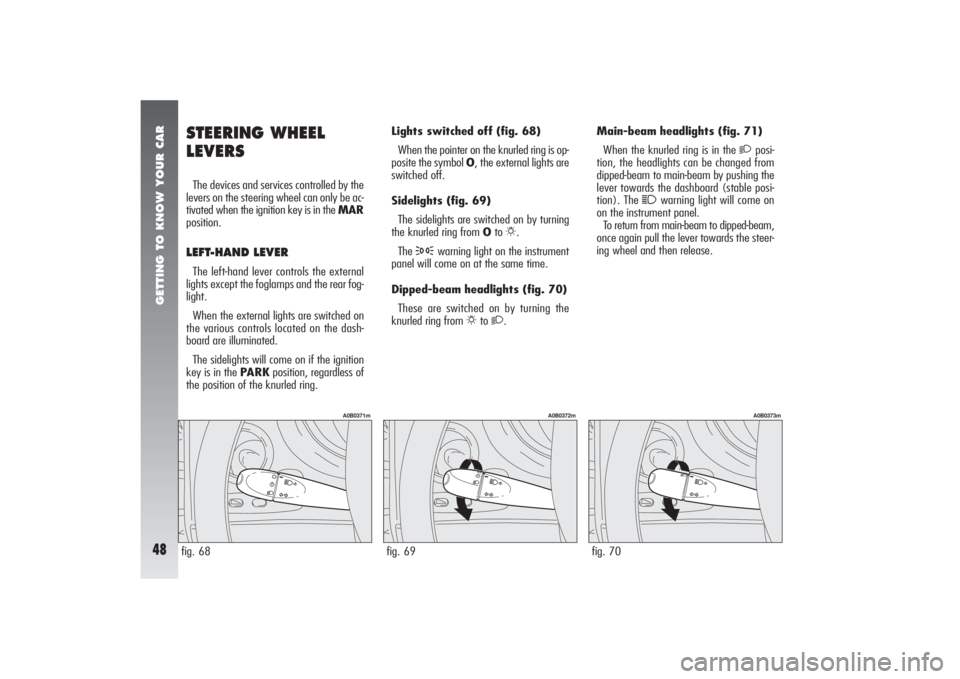
GETTING TO KNOW YOUR CAR48
fig. 70
A0B0373m
STEERING WHEEL
LEVERSThe devices and services controlled by the
levers on the steering wheel can only be ac-
tivated when the ignition key is in the MAR
position.LEFT-HAND LEVERThe left-hand lever controls the external
lights except the foglamps and the rear fog-
light.
When the external lights are switched on
the various controls located on the dash-
board are illuminated.
The sidelights will come on if the ignition
key is in the PARKposition, regardless of
the position of the knurled ring.Lights switched off (fig. 68)
When the pointer on the knurled ring is op-
posite the symbol O, the external lights are
switched off.
Sidelights (fig. 69)
The sidelights are switched on by turning
the knurled ring from Oto
6.
The
3
warning light on the instrument
panel will come on at the same time.
Dipped-beam headlights (fig. 70)
These are switched on by turning the
knurled ring from
6
to 2
.Main-beam headlights (fig. 71)
When the knurled ring is in the
2
posi-
tion, the headlights can be changed from
dipped-beam to main-beam by pushing the
lever towards the dashboard (stable posi-
tion). The
1
warning light will come on
on the instrument panel.
To return from main-beam to dipped-beam,
once again pull the lever towards the steer-
ing wheel and then release.
fig. 68
A0B0371m
fig. 69
A0B0372m
Page 51 of 357
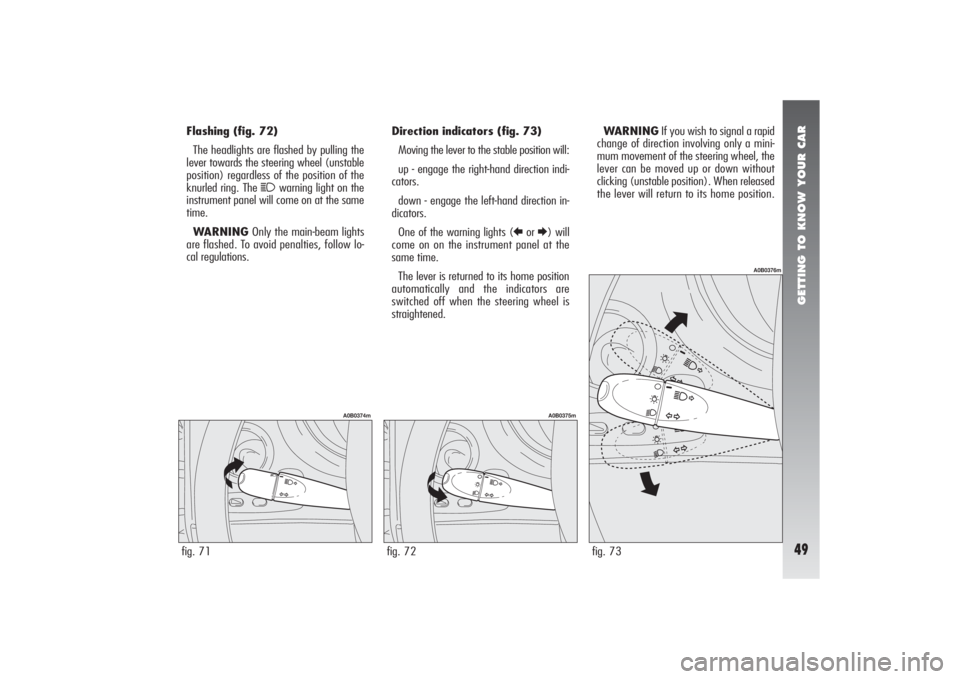
GETTING TO KNOW YOUR CAR49
Flashing (fig. 72)
The headlights are flashed by pulling the
lever towards the steering wheel (unstable
position) regardless of the position of the
knurled ring. The
1
warning light on the
instrument panel will come on at the same
time.
WARNINGOnly the main-beam lights
are flashed. To avoid penalties, follow lo-
cal regulations.Direction indicators (fig. 73)
Moving the lever to the stable position will:
up - engage the right-hand direction indi-
cators.
down - engage the left-hand direction in-
dicators.
One of the warning lights (
R
or
E) will
come on on the instrument panel at the
same time.
The lever is returned to its home position
automatically and the indicators are
switched off when the steering wheel is
straightened.WARNINGIf you wish to signal a rapid
change of direction involving only a mini-
mum movement of the steering wheel, the
lever can be moved up or down without
clicking (unstable position). When released
the lever will return to its home position.
fig. 73
A0B0376m
fig. 71
A0B0374m
fig. 72
A0B0375m
Page 53 of 357
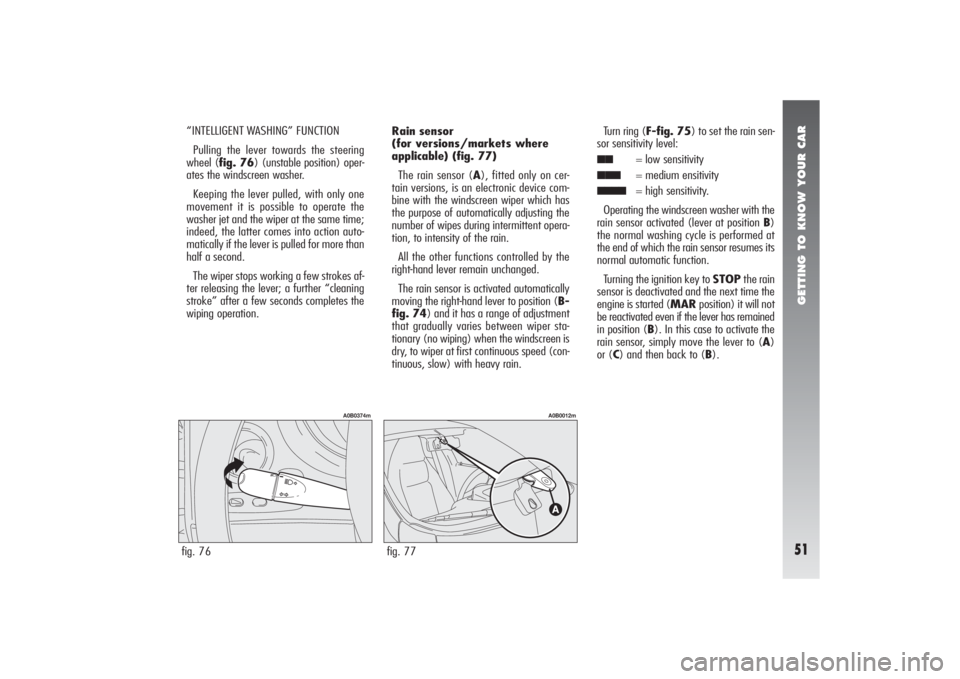
GETTING TO KNOW YOUR CAR51
“INTELLIGENT WASHING” FUNCTION
Pulling the lever towards the steering
wheel (fig. 76) (unstable position) oper-
ates the windscreen washer.
Keeping the lever pulled, with only one
movement it is possible to operate the
washer jet and the wiper at the same time;
indeed, the latter comes into action auto-
matically if the lever is pulled for more than
half a second.
The wiper stops working a few strokes af-
ter releasing the lever; a further “cleaning
stroke” after a few seconds completes the
wiping operation.Rain sensor
(for versions/markets where
applicable) (fig. 77)
The rain sensor (A), fitted only on cer-
tain versions, is an electronic device com-
bine with the windscreen wiper which has
the purpose of automatically adjusting the
number of wipes during intermittent opera-
tion, to intensity of the rain.
All the other functions controlled by the
right-hand lever remain unchanged.
The rain sensor is activated automatically
moving the right-hand lever to position (B-
fig. 74) and it has a range of adjustment
that gradually varies between wiper sta-
tionary (no wiping) when the windscreen is
dry, to wiper at first continuous speed (con-
tinuous, slow) with heavy rain.Turn ring (F-fig. 75) to set the rain sen-
sor sensitivity level:
■■
= low sensitivity
■■■
= medium ensitivity
■■■■
= high sensitivity.
Operating the windscreen washer with the
rain sensor activated (lever at position B)
the normal washing cycle is performed at
the end of which the rain sensor resumes its
normal automatic function.
Turning the ignition key to STOPthe rain
sensor is deactivated and the next time the
engine is started (MAR position) it will not
be reactivated even if the lever has remained
in position (B). In this case to activate the
rain sensor, simply move the lever to (A)
or (C) and then back to (B).
fig. 76
A0B0374m
fig. 77
A0B0012m
Page 150 of 357

GETTING TO KNOW YOUR CAR
148
fig. 131
A0B0270m
OPERATIONThe gearbox can work in two operating
modes:
– the first is semiautomatic (MANUAL),
in which the driver directly decides when to
shift gear;
– the second is completely automatic
(CITY), in which the system decides di-
rectly when to shift gear according to the
type of driving.
The CITYmode can be selected by press-
ing the specific button CITYon the gearbox
lever knob; when this mode is selected, the
CITY sign appears on the display fitted on
rev counter.
SEMIAUTOMATIC OPERATION
(MANUAL) In the MANUALoperating mode the dis-
play on the rev counter shows the gear en-
gaged.
In this operating mode, the decision to
change gear is left to the driver who decides
the most appropriate moment.
The requests to change gear can take place
through:
– the control lever on the centre console
(A-fig. 130);
– the levers on the steering wheel
(fig. 131), which can be used only when
the vehicle speed exceeds 0.5 km/h.The MANUALoperating mode is set
when, with the CITYmode selected, the
CITYbutton (B-fig. 130) is pressed
again, excluding the previously selected
mode.fig. 130
A0B0271m
Page 181 of 357
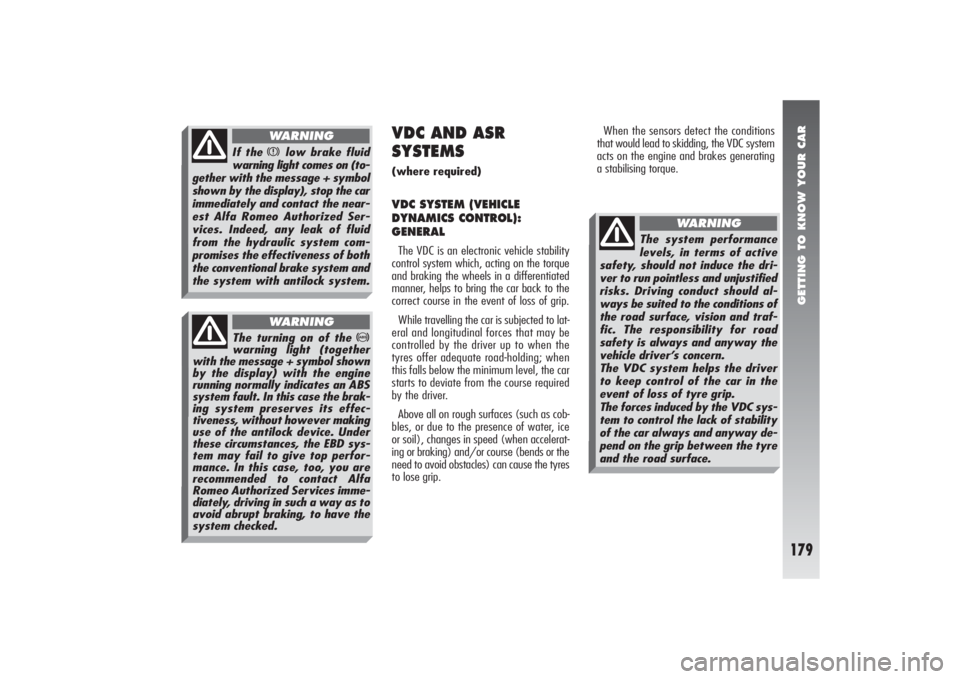
GETTING TO KNOW YOUR CAR
179
If the
x
low brake fluid
warning light comes on (to-
gether with the message + symbol
shown by the display), stop the car
immediately and contact the near-
est Alfa Romeo Authorized Ser-
vices. Indeed, any leak of fluid
from the hydraulic system com-
promises the effectiveness of both
the conventional brake system and
the system with antilock system.
WARNING
The turning on of the
>
warning light (together
with the message + symbol shown
by the display) with the engine
running normally indicates an ABS
system fault. In this case the brak-
ing system preserves its effec-
tiveness, without however making
use of the antilock device. Under
these circumstances, the EBD sys-
tem may fail to give top perfor-
mance. In this case, too, you are
recommended to contact Alfa
Romeo Authorized Services imme-
diately, driving in such a way as to
avoid abrupt braking, to have the
system checked.
WARNING
VDC AND ASR
SYSTEMS(where required)VDC SYSTEM (VEHICLE
DYNAMICS CONTROL):
GENERALThe VDC is an electronic vehicle stability
control system which, acting on the torque
and braking the wheels in a differentiated
manner, helps to bring the car back to the
correct course in the event of loss of grip.
While travelling the car is subjected to lat-
eral and longitudinal forces that may be
controlled by the driver up to when the
tyres offer adequate road-holding; when
this falls below the minimum level, the car
starts to deviate from the course required
by the driver.
Above all on rough surfaces (such as cob-
bles, or due to the presence of water, ice
or soil), changes in speed (when accelerat-
ing or braking) and/or course (bends or the
need to avoid obstacles) can cause the tyres
to lose grip.When the sensors detect the conditions
that would lead to skidding, the VDC system
acts on the engine and brakes generating
a stabilising torque.
The system performance
levels, in terms of active
safety, should not induce the dri-
ver to run pointless and unjustified
risks. Driving conduct should al-
ways be suited to the conditions of
the road surface, vision and traf-
fic. The responsibility for road
safety is always and anyway the
vehicle driver’s concern.
The VDC system helps the driver
to keep control of the car in the
event of loss of tyre grip.
The forces induced by the VDC sys-
tem to control the lack of stability
of the car always and anyway de-
pend on the grip between the tyre
and the road surface.
WARNING
Page 182 of 357

GETTING TO KNOW YOUR CAR
180
The heart of the VDC system is the VDC
control unit which with the data supplied by
the sensors installed on the car, calculates
the centrifugal forces generated when the
car is cornering. The yawing sensor detects
the rotations of the car around its own ver-
tical axis. The centrifugal forces generated
when the car is cornering are detected by
a highly sensitive lateral acceleration sensor.
The stabilising action of the VDC system is
based on calculations made by the
system’s electronic control unit which
processes the signals received from the
steering wheel rotation, lateral acceleration
and individual wheel rotation sensors. These
signals allow the control unit to recognise
the manoeuvre the driver intends to do
when turning the steering wheel.
The control unit processes the information
received from the sensors and is therefore
capable of detecting the position of the car
and comparing it with the trajectory the dri-
ver would like to follow instant by instant.
In the event of a discrepancy, the control
unit chooses and commands the most suit-
able action to bring the car back to the re-
quired course within a fraction of a second:
braking one or more wheels at a different
braking force and, if necessary it reduces the
power transmitted by the engine. The corrective actions are changed and con-
trolled continuously until the car returns to
the required course.
The action of the VDC system considerably
increases the active safety of the vehicle un-
der many critical situations and it is partic-
ularly useful also when the road surface grip
conditions change.
For the VDC, ASR and ABS
systems to work correctly,
the tyres must be of the same
brand and type on all wheels, in
perfect conditions and above all of
the specified type, brand and size.
WARNING
During use of the compact
spare wheel, the VDC sys-
tem continues working. It should be
borne in mind that the spare wheel
is smaller than a normal tyre,
therefore its grip is lower than that
of the other tyres of the car.
WARNING
VDC SYSTEM OPERATIONThe VDC system turns on automatically
when the car is started and cannot be
switched off. It is however possible to cut
off operation of the ASR system pressing the
corresponding button on the centre console.
The main components of the VDC system
are:
– an electronic control unit which
processes the signals received from the var-
ious sensors and brings about the most ap-
propriate strategy;
– a sensor that detects the position of the
steering wheel;
– four sensors that detect the rotation
speed of each wheel;
– a sensor that detects rotation of the car
around the vertical axis;
– a sensor that detects lateral acceleration
(centrifugal force).
Page 183 of 357
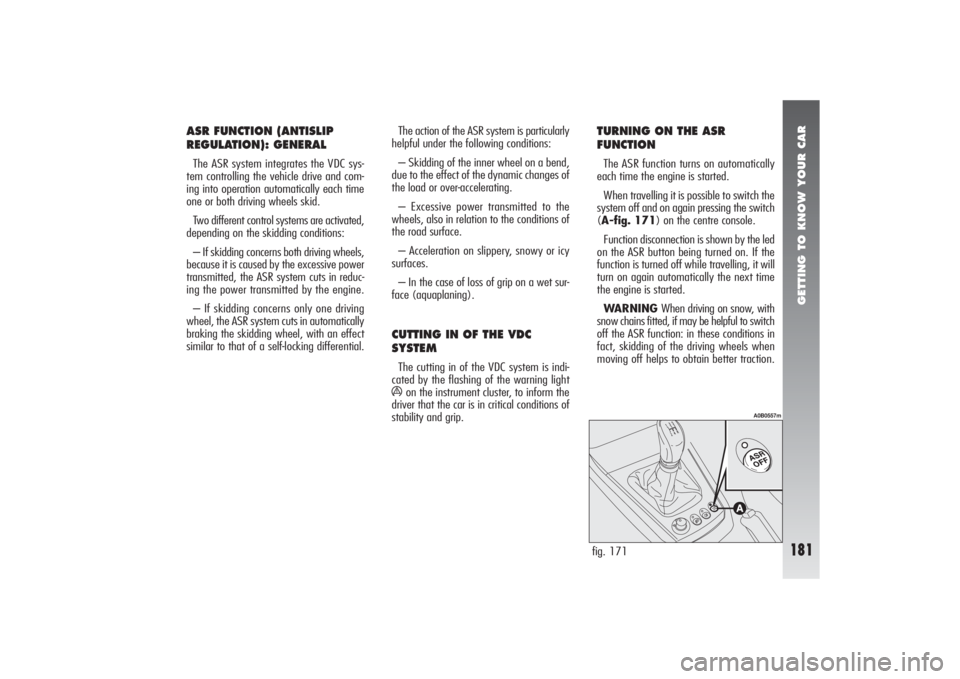
GETTING TO KNOW YOUR CAR
181
ASR FUNCTION (ANTISLIP
REGULATION): GENERALThe ASR system integrates the VDC sys-
tem controlling the vehicle drive and com-
ing into operation automatically each time
one or both driving wheels skid.
Two different control systems are activated,
depending on the skidding conditions:
– If skidding concerns both driving wheels,
because it is caused by the excessive power
transmitted, the ASR system cuts in reduc-
ing the power transmitted by the engine.
– If skidding concerns only one driving
wheel, the ASR system cuts in automatically
braking the skidding wheel, with an effect
similar to that of a self-locking differential.The action of the ASR system is particularly
helpful under the following conditions:
– Skidding of the inner wheel on a bend,
due to the effect of the dynamic changes of
the load or over-accelerating.
– Excessive power transmitted to the
wheels, also in relation to the conditions of
the road surface.
– Acceleration on slippery, snowy or icy
surfaces.
– In the case of loss of grip on a wet sur-
face (aquaplaning).
CUTTING IN OF THE VDC
SYSTEMThe cutting in of the VDC system is indi-
cated by the flashing of the warning lightá
on the instrument cluster, to inform the
driver that the car is in critical conditions of
stability and grip.
TURNING ON THE ASR
FUNCTIONThe ASR function turns on automatically
each time the engine is started.
When travelling it is possible to switch the
system off and on again pressing the switch
(A-fig. 171
) on the centre console.
Function disconnection is shown by the led
on the ASR button being turned on. If the
function is turned off while travelling, it will
turn on again automatically the next time
the engine is started.
WARNING When driving on snow, with
snow chains fitted, if may be helpful to switch
off the ASR function: in these conditions in
fact, skidding of the driving wheels when
moving off helps to obtain better traction.
fig. 171
A0B0557m
Page 195 of 357
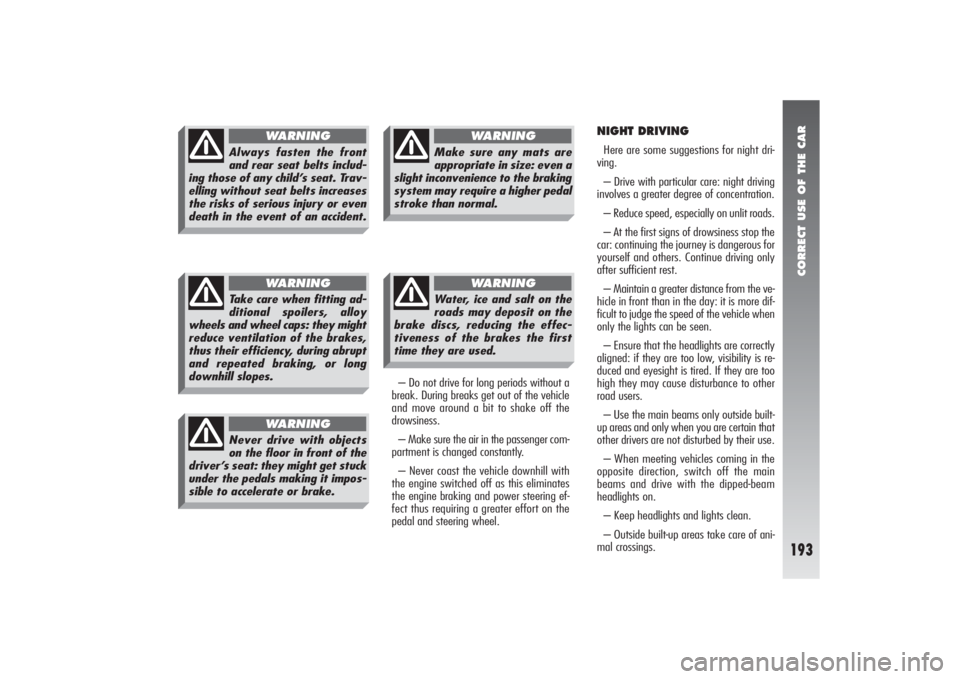
CORRECT USE OF THE CAR
193
– Do not drive for long periods without a
break. During breaks get out of the vehicle
and move around a bit to shake off the
drowsiness.
– Make sure the air in the passenger com-
partment is changed constantly.
– Never coast the vehicle downhill with
the engine switched off as this eliminates
the engine braking and power steering ef-
fect thus requiring a greater effort on the
pedal and steering wheel.
NIGHT DRIVINGHere are some suggestions for night dri-
ving.
– Drive with particular care: night driving
involves a greater degree of concentration.
– Reduce speed, especially on unlit roads.
– At the first signs of drowsiness stop the
car: continuing the journey is dangerous for
yourself and others. Continue driving only
after sufficient rest.
– Maintain a greater distance from the ve-
hicle in front than in the day: it is more dif-
ficult to judge the speed of the vehicle when
only the lights can be seen.
– Ensure that the headlights are correctly
aligned: if they are too low, visibility is re-
duced and eyesight is tired. If they are too
high they may cause disturbance to other
road users.
– Use the main beams only outside built-
up areas and only when you are certain that
other drivers are not disturbed by their use.
– When meeting vehicles coming in the
opposite direction, switch off the main
beams and drive with the dipped-beam
headlights on.
– Keep headlights and lights clean.
– Outside built-up areas take care of ani-
mal crossings.
Always fasten the front
and rear seat belts includ-
ing those of any child’s seat. Trav-
elling without seat belts increases
the risks of serious injury or even
death in the event of an accident.
WARNING
Take care when fitting ad-
ditional spoilers, alloy
wheels and wheel caps: they might
reduce ventilation of the brakes,
thus their efficiency, during abrupt
and repeated braking, or long
downhill slopes.
WARNING
Never drive with objects
on the floor in front of the
driver’s seat: they might get stuck
under the pedals making it impos-
sible to accelerate or brake.
WARNING
Make sure any mats are
appropriate in size: even a
slight inconvenience to the braking
system may require a higher pedal
stroke than normal.
WARNING
Water, ice and salt on the
roads may deposit on the
brake discs, reducing the effec-
tiveness of the brakes the first
time they are used.
WARNING
Page 196 of 357
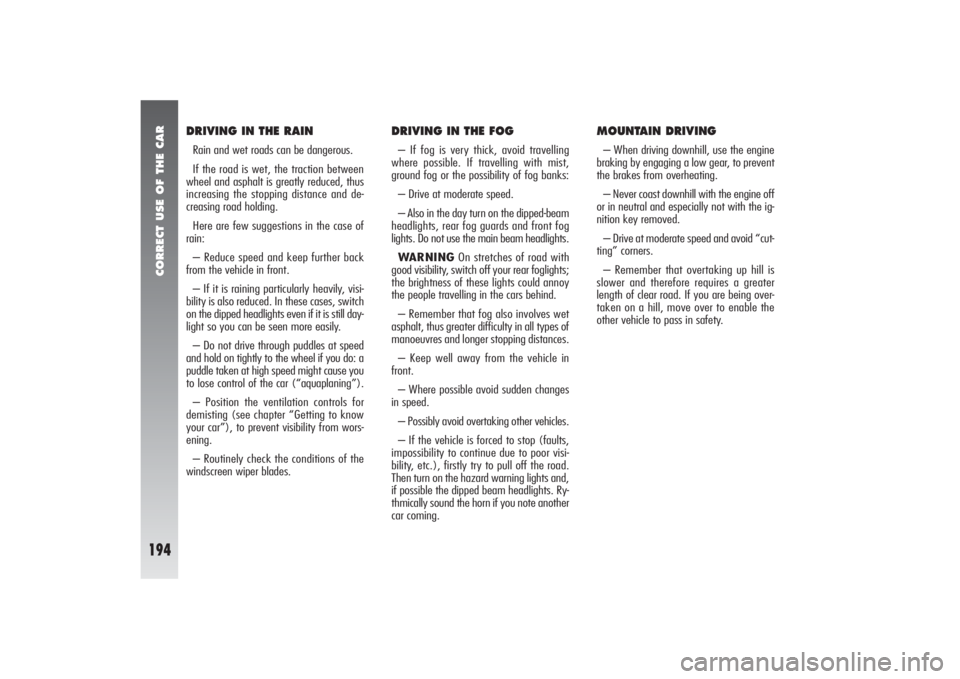
CORRECT USE OF THE CAR
194
DRIVING IN THE RAINRain and wet roads can be dangerous.
If the road is wet, the traction between
wheel and asphalt is greatly reduced, thus
increasing the stopping distance and de-
creasing road holding.
Here are few suggestions in the case of
rain:
– Reduce speed and keep further back
from the vehicle in front.
– If it is raining particularly heavily, visi-
bility is also reduced. In these cases, switch
on the dipped headlights even if it is still day-
light so you can be seen more easily.
– Do not drive through puddles at speed
and hold on tightly to the wheel if you do: a
puddle taken at high speed might cause you
to lose control of the car (“aquaplaning”).
– Position the ventilation controls for
demisting (see chapter “Getting to know
your car”), to prevent visibility from wors-
ening.
– Routinely check the conditions of the
windscreen wiper blades.
DRIVING IN THE FOG– If fog is very thick, avoid travelling
where possible. If travelling with mist,
ground fog or the possibility of fog banks:
– Drive at moderate speed.
– Also in the day turn on the dipped-beam
headlights, rear fog guards and front fog
lights. Do not use the main beam headlights.
WARNINGOn stretches of road with
good visibility, switch off your rear foglights;
the brightness of these lights could annoy
the people travelling in the cars behind.
– Remember that fog also involves wet
asphalt, thus greater difficulty in all types of
manoeuvres and longer stopping distances.
– Keep well away from the vehicle in
front.
– Where possible avoid sudden changes
in speed.
– Possibly avoid overtaking other vehicles.
– If the vehicle is forced to stop (faults,
impossibility to continue due to poor visi-
bility, etc.), firstly try to pull off the road.
Then turn on the hazard warning lights and,
if possible the dipped beam headlights. Ry-
thmically sound the horn if you note another
car coming.
MOUNTAIN DRIVING– When driving downhill, use the engine
braking by engaging a low gear, to prevent
the brakes from overheating.
– Never coast downhill with the engine off
or in neutral and especially not with the ig-
nition key removed.
– Drive at moderate speed and avoid “cut-
ting” corners.
– Remember that overtaking up hill is
slower and therefore requires a greater
length of clear road. If you are being over-
taken on a hill, move over to enable the
other vehicle to pass in safety.